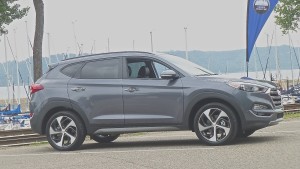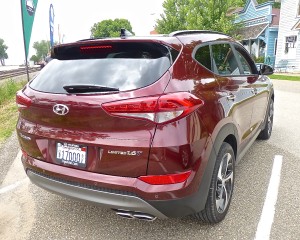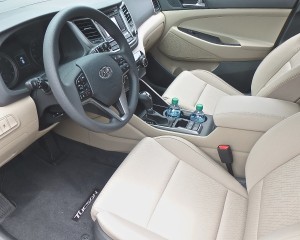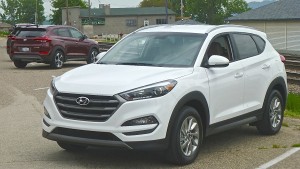All-new 2016 Tucson Lifts CUV Stature
By John Gilbert
It was just five years ago that Hyundai put South Korean automotives on the global map by redesigning the midsize Sonata from a dull sedan into a stunning, flashy and technology-filled showpiece. Almost immediately, the technology spread to all the other Hyundai cars, as well to everything from Kia, its newly adopted partner. Hyundai’s SUVs benefitted too, although they seemed almost as after-thoughts.
Since then, the SUV market has skyrocketed, so Hyundai improved the Santa Fe to new levels of function and luxury, with two versions, including a slightly shorter Sport, that keeps its distance larger than the compact crossover Tucson. For the 2016 model year, and for the first time since Hyundai technology peaked, the Tucson gets its moment in the sun, and the timing couldn’t be better for the new CUV (Crossover Utility Vehicle).
The compact crossover segment that numbered about five vehicles a decade ago now numbers over 40. Everybody has one, or two, and some are outstanding. All of them are in hot pursuit of the affordable segment stars — the Honda CR-V, Toyota RAV4, Ford Escape, Nissan Rogue, and, more recently, the Mazda CX-5.
As of right now, one out of every three vehicles sold is an SUV, and the compact CUVs are flat taking over. It makes sense, because if you want something that can haul a little more, offers more storage room, and has the anxiety-free stability of all-wheel drive, then the most compact SUVs also offer more maneuverability and fuel economy.
The Tucson used to be a more modest and less expensive alternative to the top sellers, but the new 2016 Tucson goes immediately to the head of the class. It is completely redesigned, and now resembles a compact version of the stylish Santa Fe. Its high-tech stuff either stands out immediately, or resides more subtly beneath the skin, where it makes the vehicle stiffer, handle better, is safer and more versatile.
The last Tucson redesign came in 2010, and it was a solid step upward, but nothing like this one. Before approaching the many details, consider that the new Tucson starts with front-wheel drive available as a $1,400 option in all versions. The SE starts at a base price of $22,700; the SE Pop starts at $23,450; the Eco at $24,150; the Sport at $26,150; the Limited at $29,900; and the Limited Ultimate at $32,650. It’s hard to find a capable compact car for $25,000 these days.
Tucson is a nice, warm-weather city in Southern Arizona, but Hyundai first introduced the Tucson to the media in Minneapolis, right on the University of Minnesota campus. It was a nice setting, and we enjoyed driving it through the Twin Cities and off along the St. Croix River that separates Minnesota from Wisconsin. It was a clever move by Hyundai, because not only was it a neat site, but it didn’t take much imagination to realize that in a couple of months, the weather would turn cold, and the snow would be underlined by ice — making SUVs with their all-wheel drive a great source of relief.
Surprisingly, when you first examine the Tucson close-up, it is 8.5 inches shorter than the Santa Fe Sport, a vehicle that seems compact itself. Hyundai reasons that the core family will probably choose the Santa Fe, the empty-nest family would probably choose the Santa Fe Sport, and the singles or newly married without kids will go for the Tucson.
I think Hyundai may have underestimated the Tucson, because it might remain the perfect vehicle for couples with one or two young children, and it might just as likely be the choice of the kids-are-gone couples who want the convenience of easy parking, sporty handling and high mileage. And while the kids are growing up, the Tucson would make the ideal second car.
Mike O’Brien, vice president of Hyundai’s corporate product planning, pointed to the bold and dynamic design, touches such as full-length panoramic sunroof, color luminescent instruments and an 8-inch touchscreen, LED outside lighting front and rear, 17-inch or premium 19-inch wheels, greatly improved rigidity, improved sound isolation, and two impressive new engines.
The current Tucson is 173.2 inches in overall length and the new one will be 176.2, which leaves it shorter than the CR-V, RAV4 or Escape. The current one was constructed of 18 percent high-strength steel, while the new one boasts 51 percent. That helps overall body rigidity to be improved by 48 percent, and helps the Tucson move ahead of the CR-V, RAV4 and Escape in sound suppression.
Structurally, Hyundai made all the passenger compartment pillars stronger, as well as the floor, and even the underbody is designed for improved air-management. That conspires to aid the very impressive 0.33 coefficient of drag as you slice through the wind.
Power also is improved with two engine choices. One is the 2.0-liter direct-injection 4 that has 164 horsepower and 151 foot-pounds of torque. The optional upgrade is interesting — a smaller-displacement 1.6-liter 4 that has direct injection and is turbocharged, offering 175 horsepower and 195 foot-pounds of torque that remain constant from 1,500-4,500 RPMs.
Remember, horsepower looks good in advertising, but it is torque that provides the grunt to launch a vehicle. And to get up to peak torque at 1,500 revs — barely above idle — and maintain it to 4,500 revs, is impressive indeed.
Tucsons come in either front-wheel drive or all-wheel drive, and transmission choices are a 6-speed automatic, or a 7-speed dual-clutch unit. That one is like the precise race-track shifter that has no clutch pedal, but two clutches enclosed inside the transmission. As you accelerate in, say, second gear with one clutch engaged, the computer induces the second clutch to preselect third gear, and when it comes time to shift, the transmission instantly switches which clutch is engaged.
The all-wheel drive system is an improved plan that uses gentle braking or reduced power to a wheel that wants to spin. Depending on which model and equipment you choose, you can have a governing mode that you set to Eco, Normal, or Sport, each of which adjusts the engine power, transmission shift points and steering firmness.
Suspension has been reengineered, with MacPherson struts and four-point bushings in front, multilink rear, and Sachs shocks on all four corners. The plan was to improve handling and also accident-avoidance, and inspire confidence in the driver.
I have suggested to Hyundai officials for the past few years that all the ingredients are impressive, but getting them all coordinated — and getting the steering and cornering up to proper performance levels — are all that remained. On the car side, the new Sonata, Accent, Genesis and Veloster have proven that to qualify as “mission accomplished,” and it took only a brief driving example to indicate the Tucson has carried out that same achievement.
Along with the obvious interior improvements, the new Tucson offers more. You can get 31 cubic feet of cargo behind the second row of seats, and there is a neat, dual-level cargo floor that drops 2 inches below normal floor level to secure certain things. The hands-free rear liftgate first made a feature of the entry-luxury Genesis sedan now follows the Santa Fe and is incorporated onto the Tucson; stand behind the vehicle for 3 seconds with the key fob on your person, and the hatch lifts.
There are windshield, front facia and rear view cameras, for warning that a car, or pedestrian, is entering your danger zone. While driving, sensors and radar warn the driver, and if you don’t stop, it brakes for you. That system also works for blind spot, lane change, and rear cross traffic alerts.
Rear seats are heated, along with, of course, the 10-way power driver or 8-way passenger seats. Also, it seems every company is trying to find some unique touches for audio systems. In the Tucson, when you change stations and hit on a song you like, push a switch and you can go back to the start of the song. That’s one of those black-magic tricks of modern technology, and it fits well into the new image of the new Tucson.







 John Gilbert is a lifetime Minnesotan and career journalist, specializing in cars and sports during and since spending 30 years at the Minneapolis Tribune, now the Star Tribune. More recently, he has continued translating the high-tech world of autos and sharing his passionate insights as a freelance writer/photographer/broadcaster. A member of the prestigious North American Car and Truck of the Year jury since 1993. John can be heard Monday-Friday from 9-11am on 610 KDAL(www.kdal610.com) on the "John Gilbert Show," and writes a column in the Duluth Reader.
John Gilbert is a lifetime Minnesotan and career journalist, specializing in cars and sports during and since spending 30 years at the Minneapolis Tribune, now the Star Tribune. More recently, he has continued translating the high-tech world of autos and sharing his passionate insights as a freelance writer/photographer/broadcaster. A member of the prestigious North American Car and Truck of the Year jury since 1993. John can be heard Monday-Friday from 9-11am on 610 KDAL(www.kdal610.com) on the "John Gilbert Show," and writes a column in the Duluth Reader.